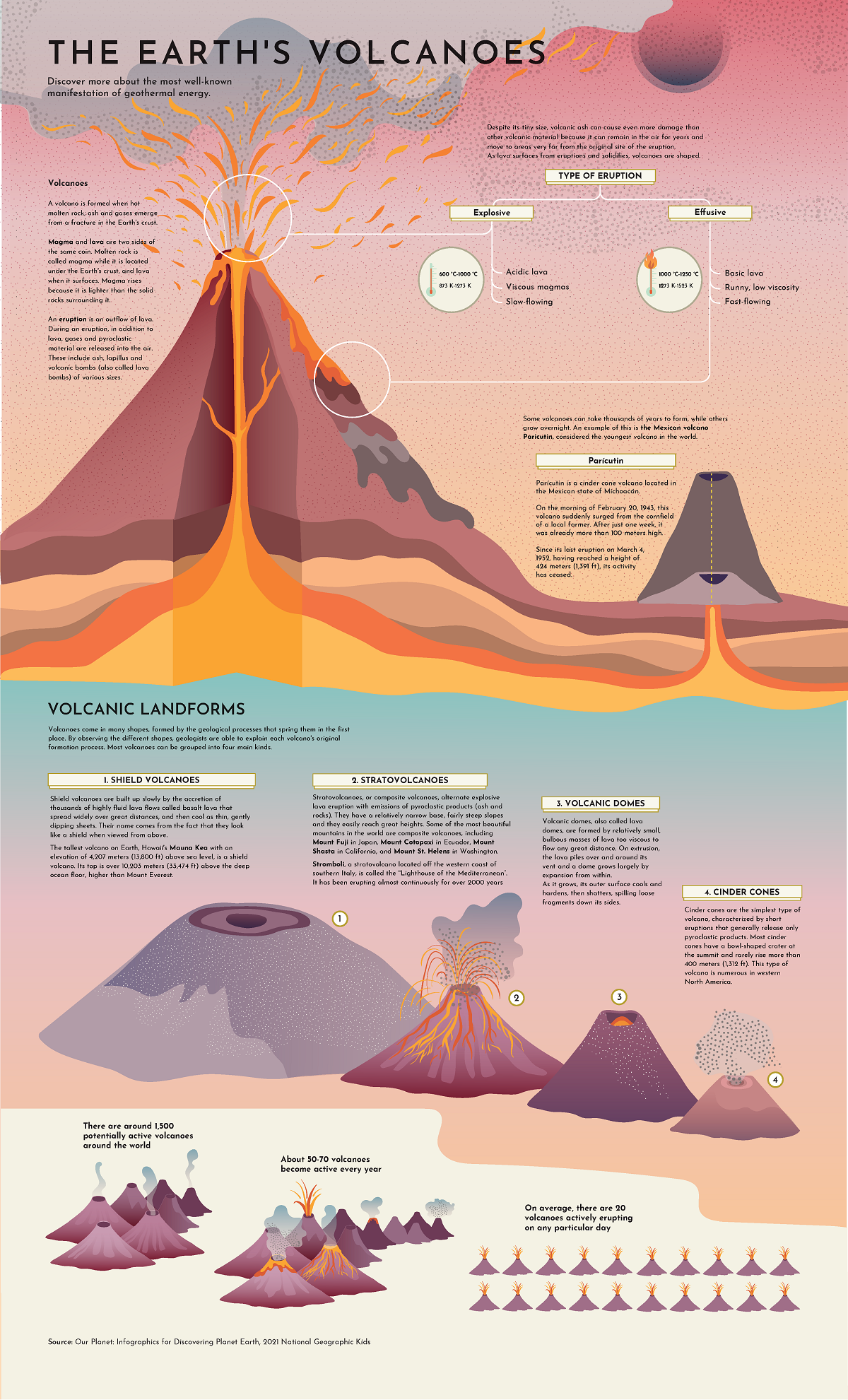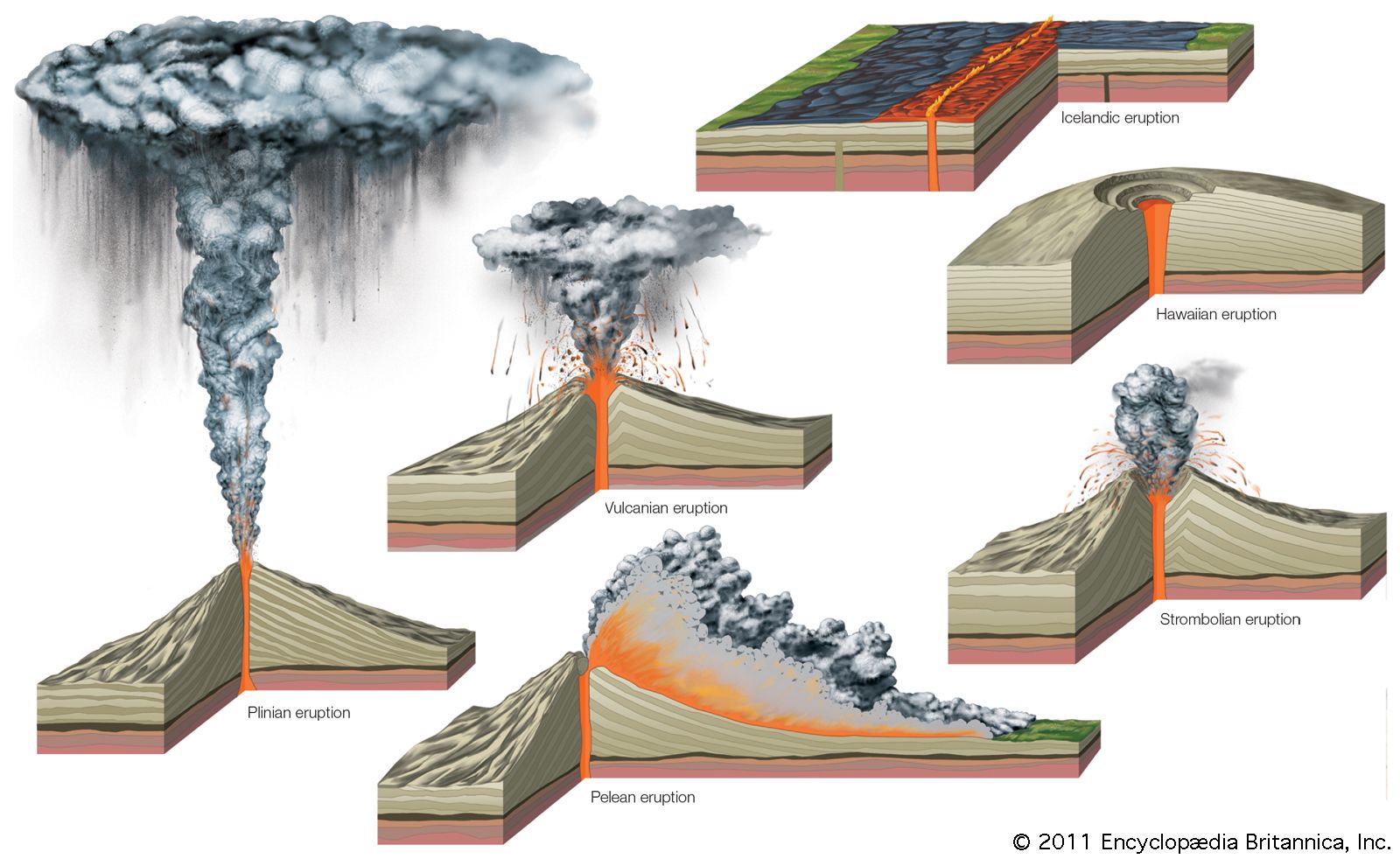Introduction
Volcanic eruptions are one of the most fascinating and powerful natural phenomena on Earth. They have shaped our planet’s landscape and have had significant impacts on human civilizations throughout history. Understanding the different types of volcanic eruptions is crucial for scientists, geologists, and anyone interested in the Earth’s geology. In this blog post, we will explore the various types of volcanic eruptions, their characteristics, and the factors that influence their explosiveness.
Hawaiian Eruptions

Hawaiian eruptions are characterized by the gentle effusion of lava from a vent or fissure. The lava flows smoothly and can travel long distances, creating shield volcanoes. These eruptions are typically non-explosive and are associated with the Hawaiian Islands.
Strombolian Eruptions
Strombolian eruptions are named after the volcano Stromboli in Italy. These eruptions are characterized by frequent and moderate explosions. The explosions eject incandescent cinder, ash, and volcanic bombs into the air. Strombolian eruptions are relatively short-lived and can occur in various types of volcanoes.
Vulcanian Eruptions
Vulcanian eruptions are explosive and violent. They are named after the volcano Vulcano in Italy. These eruptions are characterized by the ejection of large quantities of ash, gas, and pyroclastic material. Vulcanian eruptions can produce mushroom-shaped ash clouds that rise high into the atmosphere.
Plinian Eruptions
Plinian eruptions are the most explosive and dangerous types of volcanic eruptions. They are named after the Roman historian Pliny the Younger, who witnessed the eruption of Mount Vesuvius in 79 AD. Plinian eruptions are characterized by the eruption column, which can reach several kilometers in height. These eruptions release vast amounts of ash, gas, and pyroclastic material into the atmosphere.
Phreatomagmatic Eruptions
Phreatomagmatic eruptions occur when water comes into contact with magma. The water rapidly turns into steam, causing the magma to fragment into ash and volcanic bombs. These eruptions are often explosive and can produce ash clouds and volcanic ash falls.
Summary
Volcanic eruptions can be classified into several types based on their explosiveness, eruption style, and the type of volcanic material ejected. The most common types include effusive eruptions, explosive eruptions, phreatomagmatic eruptions, and pyroclastic eruptions.
Effusive eruptions occur when magma reaches the surface and flows out slowly, creating lava flows. These eruptions are typically non-explosive and are characterized by the gentle release of gases and lava. Examples of effusive eruptions include the Hawaiian and Icelandic volcanoes.
Explosive eruptions, on the other hand, involve the rapid release of gas and magma, resulting in violent explosions. These eruptions can produce ash clouds, pyroclastic flows, and volcanic bombs. The famous eruption of Mount Vesuvius in 79 AD, which buried the city of Pompeii, is an example of an explosive eruption.
Phreatomagmatic eruptions occur when water comes into contact with magma, causing explosive reactions. These eruptions often produce ash clouds, steam, and volcanic ash mixed with water. The eruption of Krakatoa in 1883, which generated tsunamis and caused global climate effects, is a well-known phreatomagmatic eruption.
Pyroclastic eruptions involve the ejection of hot fragments, ash, and gas at high speeds. These eruptions can create devastating pyroclastic flows, which are fast-moving currents of hot gas, ash, and volcanic materials. you can check here The eruption of Mount St. Helens in 1980, which caused significant destruction in the surrounding area, is an example of a pyroclastic eruption.
- Q: What is a volcanic eruption?
- A: A volcanic eruption is the release of magma, gas, and other materials from a volcano.
- Q: What are the different types of volcanic eruptions?
- A: The different types of volcanic eruptions include effusive eruptions, explosive eruptions, and phreatomagmatic eruptions.
- Q: What is an effusive eruption?
- A: An effusive eruption is a type of volcanic eruption where lava flows steadily and gently from the volcano.
- Q: What is an explosive eruption?
- A: An explosive eruption is a type of volcanic eruption characterized by violent explosions and the ejection of ash, rocks, and pyroclastic materials.
- Q: What is a phreatomagmatic eruption?
- A: A phreatomagmatic eruption is a type of volcanic eruption that occurs when water comes into contact with magma, resulting in explosive activity.
- Q: What factors determine the type of volcanic eruption?
- A: The type of volcanic eruption is determined by the composition of the magma, the amount of gas dissolved in the magma, and the presence of water.
- Q: Are all volcanic eruptions dangerous?
- A: While volcanic eruptions can be dangerous, not all eruptions pose a significant threat. The level of danger depends on various factors such as the type of eruption, proximity to populated areas, and the volcano’s history.
- Q: Can volcanic eruptions be predicted?
- A: Volcanic eruptions can be challenging to predict accurately. However, scientists use various monitoring techniques to detect signs of volcanic activity and make predictions to mitigate potential risks.

Hello wanderers, adventurers, and lovers of the great outdoors! I’m Anthony Coughlan, the heart and soul behind TerraWonders. If you’ve found your way here, it’s probably because you, like me, have an undying passion for travel, a penchant for luxury camping, or an affinity for embracing nature without compromising on comfort.

